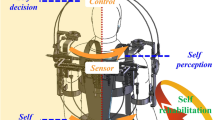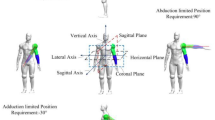Abstract
In this paper, we present an ergonomic robotic shoulder for upper limb exoskeleton. Most exoskeletons have been designed considering shoulder joint instantaneous center of rotation (ICR)—often termed as the center of glenohumeral joint—as fixed joint. In reality, shoulder joint ICR does move during shoulder abduction–adduction and vertical flexion–extension. The abduction–adduction causes shoulder joint ICR to move in the frontal plane, resulting from a combined motion of shoulder depression–elevation and horizontal translation, while vertical flexion–extension produces a movement of shoulder protraction–retraction. If these additional motions are not compensated in exoskeleton design, they can produce discomfort and/or pain to the robot’s wearer. While in most of the exoskeleton, shoulder joint articulation is considered as a 3-DOFs spherical joint, this research proposes a novel shoulder joint mechanism of robotic exoskeleton with two additional passive DOFs to provide ergonomic shoulder movement. The mechanisms in proposed robotic shoulder comprises of two sliders that allow above-mentioned passive movements of shoulder joint ICR. In this research, we demonstrated that the slider-1 enables shoulder joint ICR to move in the frontal plane with a quarter circular arc of 60 mm during abduction–adduction, while slider-2 allows movement of shoulder protraction–retraction as needed. Proposed mechanism has been designed to be used eventually in a 7 DOF modular robotic exoskeleton for upper limb rehabilitation. We have also applied computed torque control (CTC) to the designed shoulder. The performance of CTC shows stability and effectiveness.



















Similar content being viewed by others
References
Benjamin EJ, Blaha MJ, Chiuve SE, Cushman M, Das SR, Deo R et al (2017) Heart disease and stroke statistics-2017 update: a report from the American Heart Association. Circulation 135(10):e146–e603
Heidenreich PA, Trogdon JG, Khavjou OA, Butler J, Dracup K, Ezekowitz MD et al (2011) Forecasting the future of cardiovascular disease in the United States. Circulation 123:933–944
Cui X, Chen W, Jin X, Agrawal SK (2017) Design of a 7-DOF cable-driven arm exoskeleton (CAREX-7) and a controller for dexterous motion training or assistance. IEEE/ASME Trans Mechatron 22(1):161–172
Gunasekara M, Gopura R, Jayawardena S (2015) 6-REXOS: upper limb exoskeleton robot with improved pHRI. Int J Adv Robot Syst 12(4):47
Kim B, Deshpande AD (2017) An upper-body rehabilitation exoskeleton Harmony with an anatomical shoulder mechanism: design, modeling, control, and performance evaluation. Int J Robot Res 36(4):414–435
Nef T, Guidali M, Riener R (2009) ARMin III—arm therapy exoskeleton with an ergonomic shoulder actuation. Appl Bionics Biomech 6(2):127–142
Rahman MH, Rahman MJ, Cristobal OL, Saad M, Kenné JP, Archambault PS (2014) Development of a whole arm wearable robotic exoskeleton for rehabilitation and to assist upper limb movements. Robotica 33(1):19–39
Garving C, Jakob S, Bauer I, Nadjar R, Brunner UH (2017) Impingement syndrome of the shoulder. Dtsch Arztebl Int 114(45):765–776
Islam M, Spiewak C, Rahman M, Fareh R (2017) A brief review on robotic exoskeletons for upper extremity rehabilitation to find the gap between research porotype and commercial type. Adv Robot Autom 6(3):2
Jarrassé N, Proietti T, Crocher V, Robertson J, Sahbani A, Morel G et al (2014) Robotic exoskeletons: a perspective for the rehabilitation of arm coordination in stroke patients. Front Hum Neurosci 8:947
Maciejasz P, Eschweiler J, Gerlach-Hahn K, Jansen-Troy A, Leonhardt S (2014) A survey on robotic devices for upper limb rehabilitation. J NeuroEng Rehabil 11(1):3
Chen Y, Li G, Zhu Y, Zhao J, Cai H (2014) Design of a 6-DOF upper limb rehabilitation exoskeleton with parallel actuated joints. Bio-Med Mater Eng 24(6):2527–2535
Liu L, Shi Y-Y, Xie L (2016) A novel multi-dof exoskeleton robot for upper limb rehabilitation. J Mech Med Biol 16(08):1640023
Perry JC, Rosen J, Burns S (2007) Upper-limb powered exoskeleton design. IEEE/ASME Trans Mechatron 12(4):408–417
Rahman MH, Saad M, Kenné J-P, Archambault PS (2013) Control of an exoskeleton robot arm with sliding mode exponential reaching law. Int J Control Autom Syst 11(1):92–104
Stroppa F, Loconsole C, Marcheschi S, Frisoli A (2017) A robot-assisted neuro-rehabilitation system for post-stroke patients’ motor skill evaluation with ALEx exoskeleton. In: Ibáñez J, González-Vargas J, Azorín J, Akay M, Pons J (eds) Converging clinical and engineering research on neurorehabilitation II. Biosystems & biorobotics, vol 15. Springer, Cham, pp 501–505
Carignan C, Tang J, Roderick S, Naylor M (2007) A configuration-space approach to controlling a rehabilitation arm exoskeleton. In: IEEE 10th international conference on rehabilitation robotics, pp 179–187
Christensen S, Bai S (2017) A novel shoulder mechanism with a double parallelogram linkage for upper-body exoskeletons. Springer, Cham, pp 51–56
Bai S, Christensen S, Islam MRU (2017) An upper-body exoskeleton with a novel shoulder mechanism for assistive applications. In: IEEE international conference on advanced intelligent mechatronics (AIM), pp 1041–1046
Schenkman M, Rugo de Cartaya V (1987) Kinesiology of the shoulder complex. J Orthop Sports Phys Ther 8(9):438–450
Crabolu M, Pani D, Raffo L, Conti M, Crivelli P, Cereatti A (2017) In vivo estimation of the shoulder joint center of rotation using magneto-inertial sensors: MRI-based accuracy and repeatability assessment. Biomed Eng Online 16(1):34–34
Halder AM, Itoi E, An K-N (2000) Anatomy and biomechanics of the shoulder. Orthop Clin 31(2):159–176
Soltani-Zarrin R, Zeiaee A, Langari R,Tafreshi R (2017) A computational approach for human-like motion generation in upper limb exoskeletons supporting scapulohumeral rhythms. In: IEEE international symposium on wearable and rehabilitation robotics (WeRob2017), Houston, Texas, USA, pp 1–2
Hamilton N, Weimar W, Luttgens K (2012) Kinesiology: scientific basis of human motion, 12th edn. McGraw-Hill, XV, New York, p 622
Van Cott HP, Kinkade RG (1972) Human engineering guide to equipment design. [Washington]: [Dept. of Defense; for sale by the Supt. of Docs., U.S. Govt. Print. Off.]
Craig JJ (2017) Introduction to robotics: mechanics and control, 4th edn. Pearson, Upper Saddle River, p 448
Ruchika NK (2018) Finite time control scheme for robot manipulators using fast terminal sliding mode control and RBFNN. Int J Dyn Control. https://doi.org/10.1007/s40435-018-0477-0
Lakhekar GV, Waghmare LM (2018) Adaptive fuzzy exponential terminal sliding mode controller design for nonlinear trajectory tracking control. Int J Dyn Control 6(4):1690–1705. https://doi.org/10.1007/s40435-017-0387-6
Ramezani-al MR, Tavanaei Sereshki Z (2018) A novel adaptive sliding mode controller design for tracking problem of an AUV in the horizontal plane. Int J Dyn Control. https://doi.org/10.1007/s40435-018-0457-4
Farahmandrad M, Ganjefar S, Talebi HA et al (2019) Design of higher-order sliding mode controller based on genetic algorithm for a cooperative robotic system. Int J Dyn Control. https://doi.org/10.1007/s40435-019-00516-x
Brahim B, Ochoa Luna C, Saad M, Assad-Uz-Zaman M, Islam MR, Rahman M (2017) A new adaptive super-twisting control for an exoskeleton robot with dynamic uncertainties. In: IEEE great lake biomedial conference, Milwaukee, WI, USA, p 1
Garrido J, Yu W, Li X (2016) Modular design and control of an upper limb exoskeleton. J Mech Sci Technol 30(5):2265–2271
Winter DA (ed) (2009) Anthropometry. In: Biomechanics and motor control of human movement, 3rd edn. Wiley, New York, p 370
Physical Therapy Standards of Care and Protocol (2018) Department of Rehabilitation Services, Brigham and Women’s Hospital. https://www.brighamandwomens.org/patients-and-families/rehabilitation-services/physical-therapy-standards. Accessed 12 Nov 2018
Author information
Authors and Affiliations
Corresponding author
Rights and permissions
About this article
Cite this article
Islam, M.R., Assad-Uz-Zaman, M. & Rahman, M.H. Design and control of an ergonomic robotic shoulder for wearable exoskeleton robot for rehabilitation. Int. J. Dynam. Control 8, 312–325 (2020). https://doi.org/10.1007/s40435-019-00548-3
Received:
Revised:
Accepted:
Published:
Issue Date:
DOI: https://doi.org/10.1007/s40435-019-00548-3




